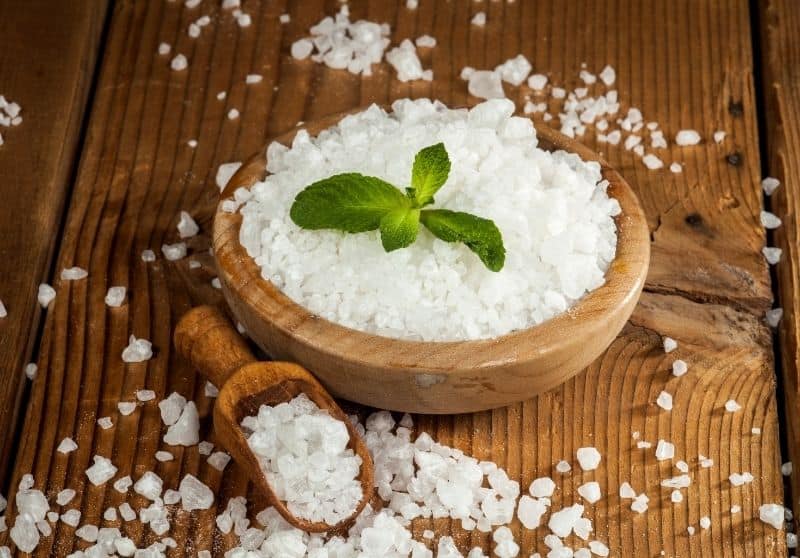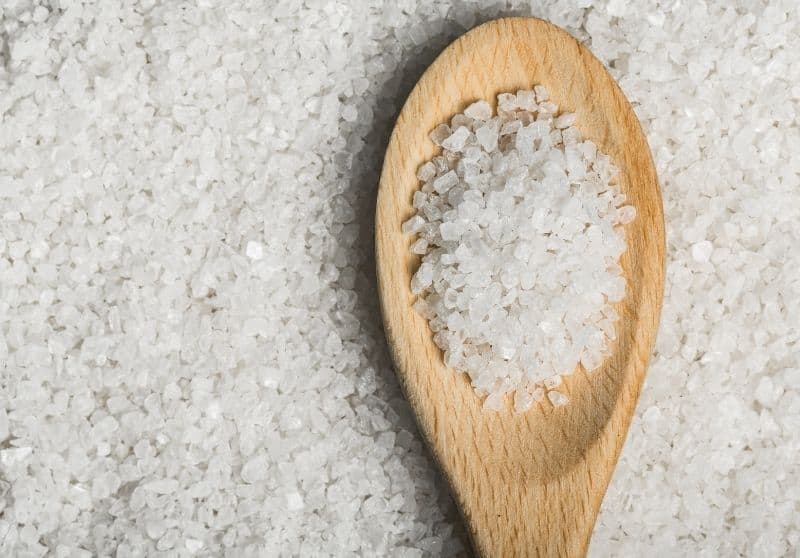There are claims that saltwater can lighten hair. If you’re wondering whether salt removes hair dye, this article will explain the effect of salt on colored hair and how you can use it to remove hair dye.

Swimming in the ocean can lighten your hair because of the high salt concentration in the water. Salt combined with the sun can even fade hair color faster.
Is Salt Bad For Hair Dye?
Salt, especially sea salt, offers several benefits for hair.
Sea salt is loaded with magnesium, calcium, potassium, and other minerals that can boost your scalp’s health and improve blood circulation.
In addition, using sea salt in your hair gives it a more textured and voluminous appearance.
Unfortunately, salt can be bad news for colored hair and hair dye.
Here are a few reasons why:
Salt Makes Hair Color Less Vibrant
Coloring hair can damage hair, so it’s essential to keep your hair moisturized afterward.
The problem with salt is it depletes the water from your tresses due to the osmotic effect.
Osmosis is when water moves from a region of high concentration to a region of low concentration.
So, when you have salt particles clinging to your hair, water will diffuse from inside the hair shaft to the outside, down a concentration gradient.
If your hair no longer holds enough water, it becomes dry, brittle, and dry. Without its natural oils, your hair loses its shine, and the color is no longer vibrant.
Salt Fades Hair Color
Salt not only makes colored hair look dull, but you may also notice some fading.
That’s because the salt can damage and open the cuticle, allowing the saltwater to penetrate the hair shaft and pull the color out.
As a result, most people who spend a considerable amount of time on the beach often notice their hair color fading.
The good news is you can prevent this by wetting your hair or applying leave-in conditioner or oil before taking a dip in the ocean.
Saturating your hair with freshwater prevents absorption of the seawater.
Similarly, oil or leave-in conditioner creates a barrier that stops the salt from interfering with the hair dye.
After exposing your hair to salt, you should also shampoo and rinse out the salt thoroughly.
Of course, if you plan to use salt to remove hair dye, you don’t have to take any preventative action.
Does Salt Remove Hair Dye?

Salt can remove hair dye and fade hair color.
This is a big part of why people with colored hair are advised to protect their hair at the beach.
There are several reasons why exposing your strands to salt could potentially remove hair dye:
- Exfoliation. Salt is a natural exfoliator. The salt can help scrub the dye molecules from your hair, though this effect may not significantly fade hair color.
- Cuticle damage. Salt can damage your cuticles, so they lift, allowing dye molecules to be washed off easily. The lifted cuticles explain why salt tends to give hair a rougher texture. If you’re swimming in the ocean, the friction with water damages the cuticle. Also, the salt’s ability to exfoliate can cause excessive abrasion, which again damages the cuticle. In addition, when salt absorbs water, it causes the hair fiber to swell, which damages and opens the cuticle, enabling more dye molecules to escape.
- Bond weakening. Salt may alter the crosslinks in your hair structure. This can also upset the way dye molecules bind to your hair. The dye molecules will bind more weakly to your hair and are easier to remove.
That being said, salt is not a very efficient method for removing hair dye. If you want to lighten your hair, taking a swim in the pool is probably better than swimming in the ocean, although chlorine is more damaging to hair.
If you’re using salt to fade hair color, you’ll have better luck with semi-permanent or temporary hair dye.
You’ll also need to apply the salt frequently together with spending more time in the sun to fade your hair quickly and noticeably.
Besides using salt, a similar dye removal method involves using bath salts or Epsom salts.
Bath salts contain baking soda, a popular, natural way to remove hair dye.
Epsom salts also help open the cuticle, striping more dye molecules.
How To Use Salt To Remove Hair Dye

The most enjoyable way to remove hair dye using salt is by spending a lot of time at the beach.
Alternatively, you can create your own salt water and use it to wash your hair:
Removing Hair Dye At The Beach
- Take a dip in the ocean (don’t wet your hair beforehand or apply conditioner or an SPF hair product)
- Relax on the beach and allow your strands to dry in the sun.
- Rinse and repeat. If you need to wash afterward, use a clarifying shampoo to help strip more color from your hair.
Removing Hair Dye At Home
- Mix some sea salt with water and apply the solution to your hair. A higher salt concentration could produce better results, but it could also damage your hair and irritate the scalp.
- Sit out in the sun if you can to allow your hair to dry.
- If you choose to rinse off the dried salt, wash your hair with clarifying shampoo.
- Alternatively, you can use a shampoo that contains sea salt or Himalayan salt. Or you can create a paste from Epsom salt, baking soda, and water.
Tips To Minimize Hair Damage When Using Salt To Remove Hair Dye
As stated, if you want to remove hair dye faster with salt, it’s best to skip actions like applying a barrier or SPF product.
These pre-exposure actions help minimize damage to hair caused by salt and the sun.
However, if you’re determined to use this dye removal method, apply these post-exposure tips for damage control.
- Use a nourishing hair mask to hydrate and strengthen your hair at least once a week.
- Deep condition your hair whenever you notice your strands becoming rougher and drier.
- Use a clarifying shampoo regularly to remove salt residue. This also helps remove more hair dye.
- Don’t apply salt to your hair every day. This will dehydrate your locks significantly, leading to brittleness and breakage.
Disclaimer: This site is not intended to provide professional or medical advice. All of the content on LovedByCurls.com is for informational purposes only. All advice should be followed at your own discretion. Ingredients may change at any time so always check the product label before using. Check our full disclaimer policy here.
